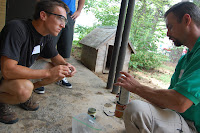I live in the suburbs of Syracuse—in Baldwinsville, NY—and do so for several reasons that in my opinion must be addressed if a city like Syracuse's is to attract middle-class professionals of my generation (that would be "X") with families.
- Schools—Quality of city versus urban schools is one of the most common reasons why families move to the suburbs. This issue raises deep, sometimes ugly feelings and history, and I don't pretend to be able to address them in this blog. Suffice it to say, as an Englishman, I have always found America's way of funding schools—funding directly from a local town/village tax base rather than a more equitable, centralized (county/state) system—to be structurally unfair. A re-densification movement would surely have to work to change the vicious (and for the wealthy suburbs, virtuous) circles the current system causes.
- Gardens/Allotments—Gardeners in my very densified home town of Brighton, England make do very well with municipal garden allotments, usually on the edge of town. My need to have a large vegetable garden was a "deal-breaker" when it came to looking for a new home. A Sustainable Syracuse would need to offer what an English city-dweller considers a "basic amenity."
- Walkable Neighborhoods & Parks—Baldwinsville's quiet street and large front lawns make up for my village's lack of real sidewalks and mini parks. But a city must have sidewalks, verges, crosswalks, bike lanes, and parks large and small if families are going to live in apartments or townhouses.
- Safety—The British have always had a good model for community policing: the "Bobby on the Beat." The simple act of a policeman walking (or biking) on a regular beat around a neighborhood, much like a postal worker getting to know everybody, goes along way toward having ordinary citizens take control of their own safety. But much like cops all over America (and increasingly in Britain), Syracuse cops rely on intimidating, hermetically sealed police cruisers to get around. There are a few bike cops, especially in Armory Square, but we need more Syracuse Bobbies!
- Shops—Basic stores such as a grocery and hardware/general stores are essential. Central Syracuse does quite poorly in this regard, although a downtown citizen does not have to go far (Erie Blvd) to find what he or she needs. The C.L. Evers grocery in the Amos Building wasn't all that clever, as it turns out—its foot traffic was too light and its hours not aggressive enough. In Britain, mega-grocer Tesco has a variety of store models ("Extra," "Express," and "Metro" stores), from out-of-town superstores to corner shops and even gas station stores: would all-powerful Wegmans ever do the same?
—Martin Walls, Syracuse Center of Excellence






















